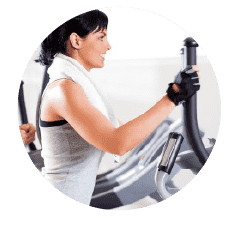7 Elliptical Machine Safety Tips
Elliptical machines are one of the greatest tools on the market for getting your cardio on, but using proper form is essential in reducing your risk of injury. Ellipticals use pedals to stimulate stair climbing without putting any pressure on your joints – they’re excellent for people with injuries, work wonders for burning fat, and are perfect for strengthening and toning muscles. But, it’s important to follow a few simple rules before hopping on that machine and pressing start. Read on for safety tips that’ll make your elliptical experience better than ever.
1. Start Slow
First off, it’s important to step on the machine slowly and carefully. Once you hit the start button, keep your movements at a slow pace, allowing your muscles to warm up and get ready for what’s to come. Stay at this pace for 5-10 minutes, then increase the speed to a higher level that’s comfortable for you. Stay at that pace for around 30 minutes, and when you’re done, always remember to cool down. If you’re looking for a routine to follow, these are great options (there’s a routine that targets just about every body part).
2. Use the Resistance
The elliptical is not only safer with a little resistance, but it’s better for you, too. According to Registered Holistic Nutritionist Yuri Elkaim, “The rotating mechanism used in ellipticals is a flywheel. This means it can use momentum to spin itself around. With the elliptical, fast feet equals lots of momentum. This means your muscles don’t have to work very hard to move the pedals around. When you bump up the resistance, your arms and legs have to work harder to keep the elliptical moving.”
3. Watch Your Heart Rate
Think of your heart rate monitor as your new best friend – it’s there for a very important reason, after all. This handy monitor keeps you within your target heart rate so you’re not overexerting yourself. The Fitness Magazine mentions that “If you see your heart rate drop after doing the same routine for a few weeks, then you’re becoming accustomed to the exercise. When that happens, mix up your activity with different intensities and durations.” To use, simply find the monitor then set your target heart rate. Place your hands on the sensors to start your workout and go! Always remember – if you’re feeling out of breath or weak, just stop!
4. Stay Hydrated
Keeping hydrated throughout your workout is crucial! Dehydration can cause dizziness, tiredness, confusion, blurred eyesight, and weakness. According to Greatist.com, “Feeling lighthearted during a workout is a sign of dehydration and a signal to tone it down a notch. Though willpower sometimes makes us want to push ourselves through a few more reps or another mile, feeling dizzy is an indicator that it’s time to hydrate.” They go on to explain, “Due to the decreased plasma volume with dehydration during exercise, the heart must work harder to get blood to the working muscles. When there’s not enough water in blood, both blood volume and blood pressure drop, resulting in dizziness.” Case in point: keep a water bottle with you at all times, and store it in your machine’s water bottle holder for safe keeping.
5. Watch Your Weight
Keep your weight distributed evenly while you get your sweat on. In other words, don’t even think about leaning on that machine for help. The key here is to stay balanced and stable so you don’t injure yourself or someone nearby.
6. Hold Your Handrails Lightly
It’s recommended that you hold onto your handrails while you’re on your machine. They’re designed to keep you secure and keep your body in the right place throughout your workout. Grip them lightly and keep your arms relaxed. If it just doesn’t feel right holding on to something, let go and place your arms by your sides, allowing them to swing naturally – just be sure to keep your back straight. Pro tip: opting for a no-handlebar workout will work your core, too!
7. Maintain Proper Alignment
If your posture is off, you won’t get the most out of your workout. Plus, you’ll be stiff and uncomfortable later on. Step on the machine with your back straight, and keep your shoulders back and your head high. Keep your core tight and you’ll be able to better maintain this perfect stance. As far as your feet, it’s important to keep them closer to the inside of the pedals. Pay attention to the weight on your heels instead of your toes and pretend you’re walking on a regular surface, starting with your heel, and rolling downwards to the middle of your foot, ending with your toes.



 Compact/Folding
Compact/Folding Front Drive
Front Drive Rear Drive
Rear Drive
1 Comment